
|
Two Standard Zoom Lenses for Four Thirds Cameras 14-45 mm versus 14-54 mm Zuiko Digital |

|
My other articles related to the |
|
Note of 2008: as of this update, the 14-45 mm ZD is no longer made, having been replaced with the compact 14-42 mm ZD (see the list below). The 14-54 mm ZD is, however, still in production, still remaining one of the more desirable Four Thirds lenses, even if facing a stiff competition from the 12-60 mm ZD (a great lens, but twice the price!). |
|
Traditionally, a "standard" lens for a given frame format is one with the focal length equal to (or slightly larger than) the diagonal of the frame. In case of the 35-mm film, that diagonal is 43 mm, and F=50 mm is traditionally recognized as "standard"; for the Four Thirds system the corresponding focal length (providing the same angle of view) is half of that, i.e., 25 mm. This focal length results in the perspective being most natural, especially when the final picture (print or screen image) is viewed from a distance close to the diagonal of the final size. This also means that this is the focal length most useful for most, if not all, shooting situations. Predominance of zoom lenses changed the situation a bit. Photographers are becoming too lazy to walk closer to (or away from) the subject to get the proper framing; they often tend just to zoom in or out, and this is not the same. Worse, many users stay mostly at or near to one or the other end of the zoom lens focal length range, neglecting the useful middle. Anyway, zoom lenses are here to stay, at least for the most general uses. Those with a focal length range centered around the "standard" value are often referred to as "standard" zooms. In terms of the EFL (equivalent focal length), a standard zoom will have a range from 28 or 35 mm to 70, 100, or even 140 mm. Extending this range from either end, although possible, comes at a price of smaller apertures, lower optical quality (resolution, vignetting, distortions), or both. This article compares directly two "standard" zoom lenses from the Olympus Four Thirds line-up:
| ||||||||||||||||||||||||||||||||||||||||||||||||||

|

| |||||||||||||||||||||||||||||||||||||||||||||||||
|
Two Olympus zooms: 14-45 mm F/3.5-5.6 (left) and 14-54 mm F/2.8-3.5 (right), mounted on an E-500 body.
(Shot with an Olympus C-5060WZ: aperture priority at F/8, WB by reference.) | ||||||||||||||||||||||||||||||||||||||||||||||||||
|
I've been using them both extensively and, yes, I like them both, too. The real question is if the mid-priced version is worth the extra money, and if you are very impatient, you can jump straight to the Bottom Line section. For the record: Olympus lists four more zooms which could be included into this group. (List updated in June, 2008):
There are a few other similar offerings, this time from Sigma and Leica/Panasonic — hheck my Four Thirds lens list. The specs and what do they mean Let us start from comparing the specs of both lenses, as provided by the manufacturer. The numbers in [] square brackets refer to my comments following the table.
| ||||||||||||||||||||||||||||||||||||||||||||||||||
| ||||||||||||||||||||||||||||||||||||||||||||||||||
First impression: make and feel Actually, the less expensive lens does not look or feel less expensive. Well, maybe just a tad. Zooming and focusing rings in both are made of the same ribbed rubber; the outer finish also looks similar, although the exposed pieces of the outer barrel in the budget lens are smooth plastic, while on the mid-priced lens they are crinkled (looks like anodized metal, but maybe an imitation; I haven't checked that). The inner barrel (sliding when the focal length changes) is of smooth plastic in both lenses. The 14-54 also has a collar grip facilitating mounting and unmounting, but this is a minor difference. It also has the manual focus scale under a transparent window, but the scale is of dubious usefulness, as I mentioned elsewhere. | ||||||||||||||||||||||||||||||||||||||||||||||||||
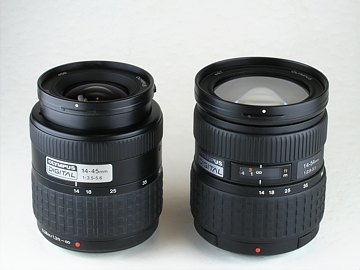
|
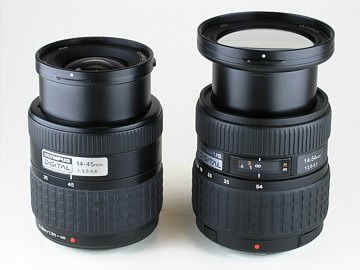
| |||||||||||||||||||||||||||||||||||||||||||||||||
|
The Olympus "standard zooms" set to the shortest (left picture) and longest (right picture) focal lengths. The 14-45 mm ZD is a bit shorter when zoomed to 25 mm. Click on images to see larger versions.
(Pictures shot with Olympus C-5060WZ: aperture priority at F/8, WB by reference.) | ||||||||||||||||||||||||||||||||||||||||||||||||||
|
Another cosmetic difference is the lens designation, painted on shiny aluminum plaque in the 14-45 mm lens, while on the 14-54 mm we have two such plaques (one with Olympus logo and another with focal length and aperture data), both using raised lettering. Looks more expensive, true, but the beauty is only skin-deep. The "fly by wire" focus ring feels similar on both lenses (and I do not like it); the zoom ring is a bit stiffer (and, maybe, more positive) on the 14-54 mm than on its cheaper cousin. Both inner barrels show similar amount of play. Surprisingly, the zoom ring action is more to my liking in the economy lens; in the 14-54 mm one it is not as smooth and uniform. This may have something to do with weatherproofing of the mid-priced lens. I would expect the more expensive lens to have more solid internal construction (including cams), as the weight of optical elements alone seems not enough to explain the 150 g difference in weight. As I haven't disassembled either lens, though, this is just a guess. Both lenses use a metal mount. The 14-45 mm lens is made in China; its more expensive sibling — in Japan. This does not seem to affect the build or finish quality to any visible degree. Weatherproofing The mid-priced (14-54 mm) lens is splash- and dust-proof; the economy (14-45 mm) one is not. A number of Readers pointed out this difference, but I consider this to be a secondary feature. Any lens will survive an occasional exposure to a light drizzle, and when it rains heavily, I take my camera inside. Besides, a weather-proofed lens makes sense only with a weather-proofed camera body. Unless you're using the weatherproof E-1, you will not experience any real advantages. Performance: vignetting As you remember, the effective aperture of a lens for off-axis subjects is less than for on-axis ones; therefore the corners of an image are getting somewhat less exposure. Our eye is usually quite forgiving in this aspect, but if the effect is visible, we refer to it as vignetting. The effect is strongest for the shortest focal lengths. So here I am, on a Sunday morning, armed with a sheet of matte-white plastic, trying to spot any differences in vignetting between both lenses. After fifty or so frames, shot with both lenses and analyzed on my computer's LCD screen both with the naked eye and with an RGB dropper tool, I may draw the following conclusions:
In most shooting situations you will not be able to spot any difference in vignetting performance between the two lenses, but nitpickers will find the 14-54 mm one slightly better in this aspect. Performance: resolution The mid-priced lens is supposed to be sharper (have higher resolution) than the budget one. This is illustrated in the following MTF charts, which I've compiled based on data posted at the Olympus Japan site (just to stress: these are measurements by Olympus, not mine). | ||||||||||||||||||||||||||||||||||||||||||||||||||
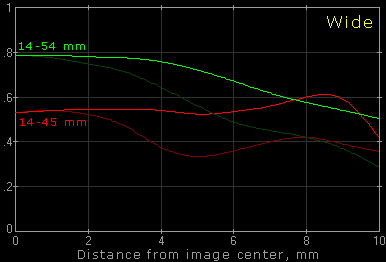
|
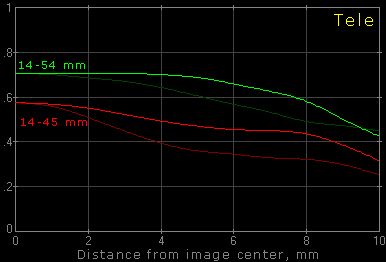
| |
| Modulation Transform Function (MTF) curves for the ZD 14-45/3.5-5.6 (red) and ZD 14-54/2.8-3.5 (green) zoom lenses, set to the shortest (left graph) and longest (right graph) focal lengths, with maximum (wide open) aperture. The pattern frequency was 30LP/mm, or 60 LW/mm (equivalent to 15/LP mm on the 35-mm film frame). MTF lines for both sagital and tangential patterns are shown in brighter and dimmer colors, respectively. | ||
|
I am not going here into a detailed discussion of the MTF used to represent lens sharpness; have a look at my general introduction to the subject. It is enough to state that our graphs at 30 cycles/mm show higher contrast for the 14-54 mm lens, which is an indication of higher resolution (better "sharpness"). This holds at both ends of the focal length range, and that in spite of the fact that the 14-54 mm lens has a wider maximum aperture. While the MTF graphs clearly show the difference, they do not allow us to say how visible this difference is when you are looking at actual images of real-life subjects. Here is where I dump the whole MTF thing and start taking pictures, to see things with my own eyes.
To put it shortly: yes, the 14-54 mm is optically better, but you will be hard pressed to see the difference. For the proof, refer to the Samples section below, Larger aperture As I have mentioned, the mid-priced lens has a larger maximum aperture, with the difference equivalent to 0.6 EV at the wide end, and 1.3 EV at the longest focal length. This translates into three effects, all in favor of the 14-54 mm lens:
For many users these factors may be enough of a reason to spend the extra money, even if all other things were equal. The lens magnification may change with the distance of the object from the axis. This leads to straight lines being depicted as curved, if they are not radial (passing through the image center). Obviously, the effect is most visible for lines running close to image edges. If such lines are shown as bending inwards, the distortion is referred to as pincushion; if outwards — barrel. For most zoom lenses, at least the decent ones, the only real problem is pincushion distortion at the shortest focal lengths (widest image angles). I haven't measured the distortion in either lens, but here is something better: a head-to-head comparison, taken from a sample shown further down. Both images are full-width fragments, resized to fit the width of this page. |
|
| |
| 14-45 mm at 14 mm | |
|
| |
| 14-54 mm at 14 mm |
|
Clearly, the economy lens exhibits some amount of barrel distortion at the widest-angle setting. I haven't measured this, but my guess would be a tad more than 1%, quite acceptable. The mid-priced lens gets rid of that effect — almost entirely. You can still see some (use an edge of a sheet of paper against your screen as a reference), but nothing worth mentioning. This is as good as I have seen in any 28 mm EFL lens. Distortion often depends also on focusing distance. My impression is that it is more visible in both lenses at distances of less than one meter or so, with the 14-54 mm, again, clearly showing less of the effect. Close-focus capability I was able to verify the manufacturer's claims regarding close-focusing capabilities of both lenses, by changing the subject-to-camera distance until no AF was any longer possible.
The pictures below may serve as a quick-and-dirty demonstration of the difference in close-focusing between both lenses. It turns out the 14-54 mm lens can be quite useful in such applications. | ||
.t.jpg)
|
.t.jpg)
| |
|
14-45 mm ZD at 45 mm, distance of 38 cm.
Field of view: 105 mm across. |
14-54 mm ZD at 45 mm, distance of 22 cm.
Field of view: 65 mm across. | |
|
The samples Comparing MTF graphs is very useful for those who want their lens to give best MTF results. Shooting resolution targets is also good — for those who want to have best pictures of resolution targets. While these methods can easily spot a really bad lens, for lenses of decent quality I've learned to trust a careful inspection of enlarged images. And here I've run into some problems. While, for example, I was easily able to tell the difference in performance between two longer zooms I've tried: the Sigma 55-200 mm DC and Olympus 40-150 mm ZD, of which the latter is clearly better, with these "standard" zooms by Olympus I was hard pressed to tell the results apart. Yes, this is true: in most situations I find it quite difficult to see any difference in performance between these two lenses, with price differing by a factor of two. Here is an example, two pictures shot handheld, within a few seconds apart. I am not going to tell you right away which is which, have a look first. As always in my samples, images at the left are full frames, reduced in size and re-sharpened, with the red frame showing the location of full-sized fragments which are shown at the right. The latter are unprocessed (just cropped), and re-saved as low-compression JPEGs. | ||
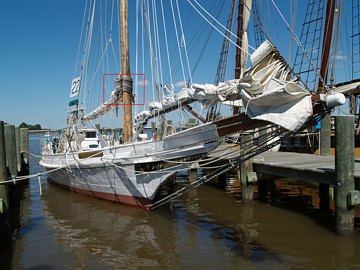
|
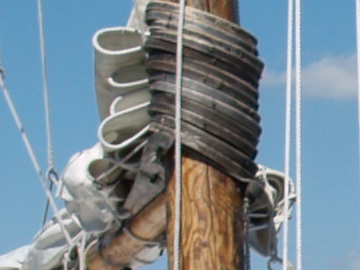
| |
| E-500, Lens A; program exposure (-0.3 EV): 1/200 s at F/9, ISO 100, WB at 5300K, Natural picture mode; contrast at -1, sharpness at -2, saturation at 0. The full frame can be found here. | ||
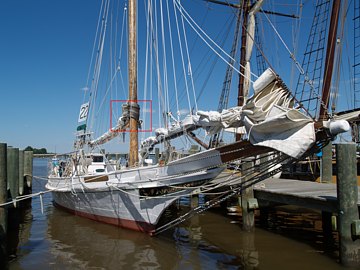
|
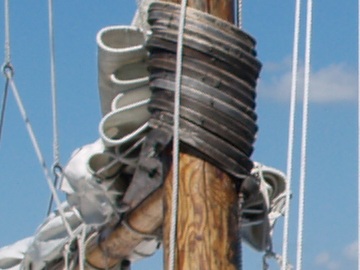
| |
| E-500, Lens B; program exposure (-0.3 EV): 1/320s at F/8, ISO 100, WB at 5300K; other settings as above. Here is the full frame. | ||
|
True, under sunny conditions the aperture was stopped down quite a bit, and this is where most lenses will perform respectably. Still, even at wider apertures I experienced problems with this exercise. The pictures were taken at the wide end of the zoom, so there was plenty of depth of field available, and the focus was set at the full-size sample area. Nota also that my in-camera sharpening is set way down; I believe that it is more proper to do sharpening at the post-processing stage. OK, here it is: Lens A (top) is the 14-45 mm, "economy" zoom, lens B (bottom) — the 14-54, mid-priced one. (The economy lens was set to 16 mm to provide a similar frame; with no tripod I might have moved a bit when changing lenses.) Clearly, a couple of casual shots is not enough to see any differences in lens quality, as long as both lenses are "good enough", which seems to be the case. Small differences in AF accuracy, for example, may affect images to a greater degree. Therefore here is a series of comparative samples shot under more controlled conditions. A medium-weight tripod was used to provide exactly the same standpoint and greater camera stability, and this series was shot at the maximum aperture (smallest F-number), which puts the "economy" lens at some advantage; fine with me. Most importantly, the series below was shot with the camera in the Manual Focus mode, autofocusing done by pressing the Lock button, and with a five-frame focus bracketing, to select the sharpest image out of the series. (As it turned out, in each case the first frame, as set by the AF system, was the best, so the precaution was not really needed. This just confirms that the system works fine.) All these images were shot in the Vivid picture mode, with sharpness adjusted to -1; white balance manually set to Sunny (5300K). Images were saved as JPEG SHQ files (compression of 1:2.7). First, the samples at the widest focal length of 14 mm (28 mm EFL): | ||
.r.jpg)
|
.f.jpg)
| |
| E-500, 14-45 mm ZD at 14 mm, aperture priority (-0.3 EV): 1/1250 s at F/3.5; ISO 100. | ||
.r.jpg)
|
.f.jpg)
| |
| E-500, 14-54 mm ZD at 14 mm, aperture priority (-0.3 EV): 1/2000 s at F/2.8; ISO 100. | ||
|
As we can see, the mid-priced lens seems to be just a tad sharper; this was confirmed by my wife and myself scrutinizing the full-size samples blind, i.e., not knowing which is which. The difference, though, is really small. Next, samples for the "normal" focal length of 25 mm (50 mm EFL): | ||
.r.jpg)
|
.f.jpg)
| |
| E-500, 14-45 mm ZD at 25 mm, aperture priority (-0.3 EV): 1/800 s at F/4.2; ISO 100. | ||
.r.jpg)
|
.f.jpg)
| |
| E-500, 14-54 mm ZD at 25 mm, aperture priority (-0.3 EV): 1/1250 s at F/3.1; ISO 100. | ||
|
Here the difference in favor of the 14-54 mm lens, although still small, is a bit more visible. Lastly, a comparison at the telephoto end, which is 45 mm (EFL of 90 mm) for the economy lens, and 20% longer, or 54 mm (EFL 108 mm) for the mid-priced one: | ||
.r.jpg)
|
.f.jpg)
| |
| E-500, 14-45 mm ZD at 45 mm, aperture priority (-0.3 EV): 1/200 s at F/5.6; ISO 100. | ||
.r.jpg)
|
.f.jpg)
| |
| E-500, 14-54 mm ZD at 54 mm, aperture priority (-0.3 EV): 1/500 s at F/3.5; ISO 100. | ||
|
The comparison is not as straightforward for these samples because of the 20% difference in focal length, working in favor of the mid-priced lens. Still, the latter appears to have a slight edge here, if only by a small margin. Keep in mind, though, that the shooting aperture is by 4/3 EV larger for that lens. To be frank, I should have applied a -0.7 compensation here, to extract the weathered wood texture better. Never trust the camera's automation; as a human you are supposed to be smarter! This adjustment is applied in the next sample: | ||
.r.jpg)
|
.f.jpg)
| |
| E-500, 14-45 mm ZD at 14 mm, aperture priority (-0.3 EV): 1/320 s at F/8; ISO 100. | ||
.r.jpg)
|
.f.jpg)
| |
| E-500, 14-54 mm ZD at 54 mm, aperture priority (-0.3 EV): 1/320 s at F/8; ISO 100. | ||
|
The slight edge the mid-priced lens has here is not a surprise. Have a look at the bottom of the shack, though: clearly, it is curving out in the first sample. This shows the effect discussed above in the Distortion section. One more comparison, this time shot without focus bracketing, but with a tripod; lens at F/8, widest angle. The focus was set at the wooden stairs. | ||
.r.jpg)
|
.f.jpg)
| |
| E-500, 14-45 mm ZD at 14 mm, aperture priority (-0.3 EV): 1/320 s at F/8; ISO 100. | ||
.r.jpg)
|
.f.jpg)
| |
| E-500, 14-54 mm ZD at 14 mm, aperture priority (-0.3 EV): 1/320 s at F/8; ISO 100. | ||
|
Surprisingly, even when both lenses are stepped down to F/8, the mid-priced one has an advantage, as slight as it may be. I expected to see no differences at this aperture. In addition, the image shot with the 14-45 mm lens seems to have a slightly cooler tonality. I would rather attribute that to a small cloud momentarily obstructing the sunlight (the shots were taken 37 seconds apart), as other pictures of the wooden boardwalk series, and I shot 16 of those, do not show a similar effect. I'm afraid you may be sick and tired of looking at image samples; so am I. To recap my impressions regarding lens resolution:
OK, so now we are ready for... After almost two years with the "economy" 14-45 mm lens and a solid few months with the "mid-priced" 14-54 mm one, I may say that both are good, with the 14-54 mm — somewhat better. While the advantage in optical quality is not always large enough to be visible (the 14-45 mm is "good enough" for most of my uses), the wider aperture makes quite a difference, and closer focusing is a bigger advantage than it may seem at the first glance. Also, the wide-angle distortion is almost non-existent. The (slightly) longer tele end is a nice bonus as well. If you've got your camera with the 14-45 mm "kit" lens, should you run out and spend another $400 to get the 14-54 mm one? Not unless you're an advanced photographer, convinced that it is the lens, not yourself, being the bottleneck at least in some of your pictures; or if you really need the larger apertures (more DOF control) and/or better close-focusing capability. Or — if you just have to have the best. My experience with the more expensive lens was very good. I brought it along to a vacation trip to Anguilla, where it got a good work-out, especially as a portrait lens near the long end, fully open. | ||
|
Here is an example, a snapshot off the hip. The picture would be almost as good were it shot with the 14-45, but the background would be more distractive; the picture would lose some of its dimensionality. Oh well, maybe it's all in my head... |

| |
|
E-500, 14-54 mm zoom at 49 mm (98 mm EFL); aperture priority (-0.3 EV): 1/1000 s at F/3.5, ISO 400; Natural picture mode, WB at 5300K. No postprocessing except for re-sizing and re-sharpening.
| ||
|
All right, so disregard what I just said above about upgrading. If you have a $400 to spare, go and get the 14-54 mm lens. Let's face it: the 28-110 mm EFL range is what we use to take 90% of our pictures. Don't these 90% deserve as good a lens as you can get? A second opinion Great minds think alike: my British friend and a fellow E-System user, John Foster, just posted his comparison of all three Olympus "standard" zooms, adding the 17.5-45 mm ZD, and throwing in some impressions on other lenses as well. In general, John's conclusions are close to mine, but check for yourself. Note of 2008: When going through John's 1:1 samples, keep in mind that they were shot with a five-megapixel E-1. The limited pixel resolution of this camera (30% linear difference from the E-500, 41% from the E-510 or E-3) may hide some of the lens resolution diffrences — once that resolution is "good enough" for that pixel count. Other Web resources The German PhotoZone site used to have extensive reports on both lenses, but they have been taken off air in 2008, perhaps because the tests, measuring the joint lens/camera performance, were done with use of the eight-megapixel E-300 — which, additionally, seems to have a stronger blur (anti-aliasing) filter than the newer models (E-410, E-510, E-3). If you are ready to accept this caveat, you may use the Wayback Machine archives to dig up these articles (both posted in 2005, archived in August, 2007): I still consider them a recommended reading. (Warning: the pages will load quite slow; this is the price you pay for accessing archived Web contents.) | ||

|
My other articles related to the |
|
Olympus® is a registered trademark of Olympus Corporation.
This page is not sponsored or endorsed by Olympus (or anyone else) and presents solely the views of the author. |
| Home: wrotniak.net | Search this site | Change font size |
| Posted 2006/07/01; last updated 2008/06/28 | Copyright © 2006-2008 by J. Andrzej Wrotniak |